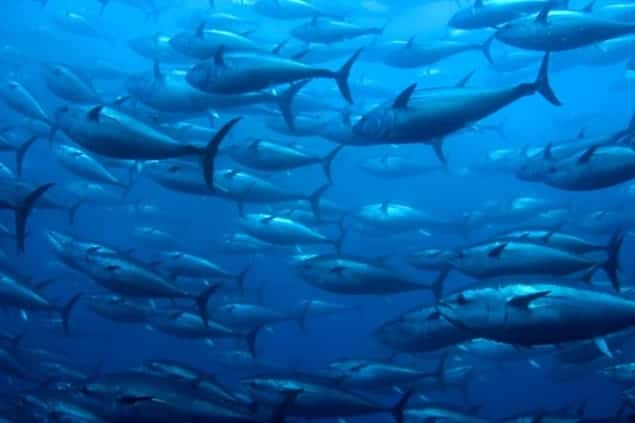
Pacific bluefin tuna off the California coast have been found to contain levels of radioactive caesium isotopes that are around 10 times higher than expected. It is believed that the fish ingested the caesium following a discharge of radioactive material into the ocean near the earthquake- and tsunami-damaged Fukushima Daiichi nuclear power plant in March 2011.
“Our work suggests that Pacific bluefin tuna were exposed to enough radioactivity off Japan to measure it months later in California,” Dan Madigan of Stanford University in the US told physicsworld.com. “This means that bluefin and other migratory animals may carry this signal if they have come from Japan in recent months. This suggests the use of these radioactive isotopes as tracers of movement in the Pacific Ocean on a large scale.”
Madigan and colleagues from Stony Brook University, US, found caesium-134 and caesium-137 in 15 two-year-old Pacific bluefin tuna (Thunnus orientalis) that were caught near San Diego in August 2011. The fish spawns in the western Pacific; some juveniles stay in Japanese waters, while others swim east to the California Current Large Marine Ecosystem, generally when they are around a year old. That means all two-year-old Pacific bluefin caught during summer in the eastern Pacific must have migrated recently.
Migrating across the Pacific
“After the Fukushima accident, there was a lot of attention to the possibility that fish may accumulate and transport radioactive material,” says Madigan. “Since Pacific bluefin are known to migrate across the Pacific, we chose to test them for two elements of radioactive caesium.”
The team found radioactivity levels of around 4 becquerels per kilogram (Bq/kg) dry weight of 134Cs and roughly 6 Bq/kg of 137Cs in the white-muscle tissue of fish sampled in late summer 2011. Pacific bluefin caught before Fukushima and yellowfin tuna, which tend to stay in Californian waters, contained no 134Cs and only background concentrations of 137Cs.
“Tagging studies of tuna, such as the TOPP [Tagging of Pacific Predators] programme, let us know that young bluefin migrate across the Pacific – making them logical test animals – and that yellowfin in the eastern Pacific tend to be generally residential in the eastern Pacific, making them logical ‘control’ animals to test for uptake of radiocesium in the east Pacific,” says Madigan.
Ten times higher, but safe
The total caesium concentrations in the post-Fukushima fish were roughly 10 times higher than before the leaks. But the levels were low compared with naturally occurring radioactive isotopes of potassium and polonium, and an order of magnitude less than the Japanese safety limit of about 400 Bq/kg dry weight for human consumption. The researchers calculated that the fish lost 1.9% of the caesium from their tissues per day as they migrated – which means they would have contained radiocaesium concentrations 1.5–15 times higher than the measured values before they left Japan.
The two caesium isotopes were released in near-equal amounts at Fukushima. 134Cs (half-life 2.1 years) decays faster than 137Cs, which has a half-life of 30 years. The team used the ratio of 134Cs and 137Cs in the fish caught in California, which was 0.62 on average, to work out that the fish had left Japanese waters four months earlier. This suggests that the fish were exposed to contaminated waters for less than one month.
This is the first time that caesium ratios have been employed to track movements of animal life; the team believes that further investigations will help confirm the accuracy of such calculations.
The team estimates that much less than 1% of the radiocaesium released into Japanese waters has been transported to the California Current Large Marine Ecosystem in tuna that have then been caught.
Tracing migrations
“[The results] demonstrate the ability for migratory animals to transport radioactive material,” says Madigan. “They suggest that these tracers may be of use, for a finite period of time, to study migratory patterns of marine animals that use the waters around Japan and then migrate large distances.”
The researchers believe that loggerhead turtles, salmon sharks, sooty shearwaters, pinnipeds, whales and billfish may also have transported radiation from Fukushima.
“We will be testing more bluefin, of many sizes, in California waters in 2012,” says Madigan. “This will give us an idea of the amount of radioactivity (if any) that these animals are carrying more than a year after the Fukushima disaster. We will also be measuring radiocaesium in other Pacific predators to examine the possibility that other species transported radioactive caesium to other regions, and to gain insight into the movements of the predators themselves.”
Madigan and colleagues will report their work this week in PNAS.



